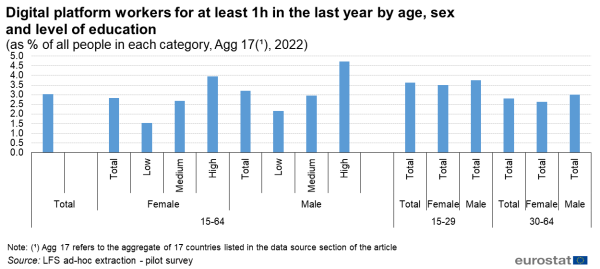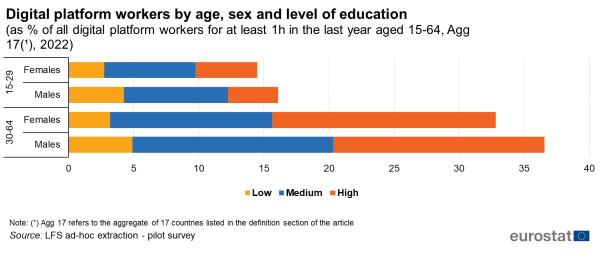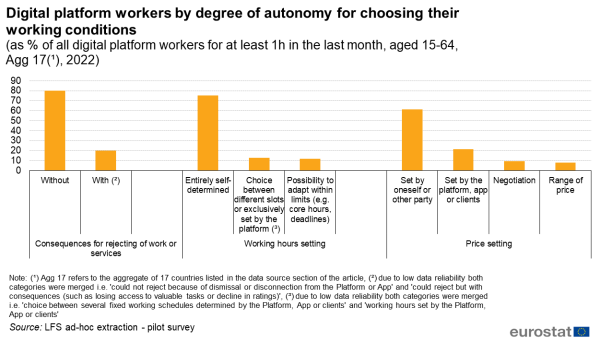Main concept and data collection
The pilot data collection on digital platform employment consisted of a small-scale preliminary survey. It was designed to evaluate and refine the research methodology, questionnaire design, data collection procedures, and overall feasibility of a full-scale survey. The specific questions on digital platform employment were included as a module questionnaire in the EU Labour Force Survey (LFS), and countries participated voluntarily.
The data were transmitted by 16 EU countries: Belgium, Denmark, Ireland, Greece, France, Italy, Cyprus, Latvia, Hungary, Malta, the Netherlands, Poland, Portugal, Romania, Slovenia and Finland, and one EFTA country, Norway.
The operational definitions that were used in this context set out that:
- A digital platform worker is a person who has worked for pay or profit in tasks or activities organised through an internet platform or a phone app, for at least one hour in at least one week, during the reference period.
- Any task or activity that can be considered as ’employment’ in the EU Labour Force Survey (LFS), i.e. production of goods or provision of services but also time spent in searching for clients or in setting up the working activity, should be considered as digital platform employment when the other criteria are fulfilled. It includes in particular, work for pay and profit: (1) for providing taxi or transport services including driving clients, delivery of food for restaurants, or transport or delivery of any kind of goods or similar, (2) for providing actual services to rent out a house, a room or any other accommodation, (3) for selling any good produced or bought to sell it online, and (4) for providing other kinds of services or work, among others: cleaning, handiwork, child or elderly care, teaching, programming and coding, online support or checks for online content, translation, data or text entry, web or graphic design, medical services (this includes, for example, the use of platforms managing appointments by physicians) and creating contents such as videos or texts (to earn money or other benefits).
- An online platform is a digital online service that facilitates interactions between two or more distinct but interdependent sets of providers and clients who interact through the service via the internet.
Extent and profile of digital platform workers in the last year
In 2022, 3.0 % of people reported digital platform employment in the last 12 months
Among all 17 countries for which 2022 data is available as a whole, 3.0 % of all people aged 15 to 64 performed at least one hour in digital platform employment (DPE) in the last 12 months. Among them, the vast majority (80.1 %) reported only one type of digital platform activity while 15.5 % worked in two different categories of digital platform employment, 3.3 % in 3 categories and the remaining 1.0 % in 4 categories or more.
Regarding the type of task or activity, 1.0 % of all people aged 15-64 reported working at least one hour in transport services, i.e., the delivery of food or other goods for pay or profit through an internet platform or app in the last year (see Figure 1). The category ‘goods selling’ ranked second with 0.7 % of all people aged 15-64 that reported having carried out the sale of goods which were collected, bought or produced specifically to sell them. It was followed by the category ‘taxi services’ with 0.4 % of all people aged 15-64. Furthermore, the digital platform tasks or services ‘medical and health care services’ and ‘renting out accommodation’ were performed by 0.3 % of people aged 15-64, while ‘creating content’, ‘other tasks or services’ and ‘online support’ were performed by 0.2 %. Finally, the categories ‘IT’, ‘cleaning or handiwork’, ‘tutorial or teaching’, ‘child and elderly care’ and ‘translation’ were each reported by 0.1 % of all people aged 15-64.
The higher the level of education, the higher the share of digital platform workers
To know more about the profile of digital platform workers in 2022, Figure 2 shows the share of people who reported digital platform employment in the last 12 months broken down by sex, age and level of education.
- It can be seen that males aged 15-64 were more likely to work through digital platforms or apps (3.2 % of all males aged 15-64) than females in the same age category (2.8 %), i.e. a difference between sexes of 0.4 pp. This was also true for young people aged 15-29 or those aged 30-64, for which the difference between males and females reached respectively 0.3 pp. and 0.4 pp.
- Looking at age group, young people aged 15-29 recorded a higher share of digital platform workers (3.6 %) than people aged 30-64 (2.8 %). More precisely, 3.5 % of young females and 3.8 % of young males reported digital platform employment in the last 12 months against 2.6 % and 3.0 % for their female and male counterparts aged 30-64.
- Interestingly, people with a high level of education i.e., those that attained a tertiary degree, recorded a higher share of digital platform employment than people with a medium level of education i.e. upper secondary at most or with a low level i.e. lower secondary at most. Females and males aged 15-64 with a high level of education recorded a share of 3.9 % and 4.7 % respectively, compared with 3.0 % or less for females and males with a medium or low level of education (see Figure 2).
Figure 3 shows the distribution of people who worked at least one hour through a digital platform or app during the last year by age, sex and level of education. Digital platform workers can be roughly divided into three main parts: young people aged 15-29 (30.6 %), females aged 30-64 (32.8 %) and males aged 30-64 (36.6 %). It is relevant to note that among digital platform workers, one third (33.4 %) were people aged 30-64 with a high level of education.
Working conditions of digital platform workers in the last month
More than half of digital platform workers reported platform income corresponding to less than a quarter of total personal earned income
Based on the results collected through the pilot survey on digital platform employment in 2022, 1 in 5 people (21.5 %) who worked in tasks or activities organised through an internet platform (or a phone app) during the last year also reported such activity in the last month.
Among digital platform workers who recorded a task or activity for pay or profit during the last month, 33.5 % worked between 1 to 9 hours, 22.2 % between 10 to 29 hours and 22.7 % more than 30 hours while 21.7 % worked for less than 1 hour during the month. Another relevant finding concerns the income from digital platform employment: more than half of the workers (52.2 %) reported a share of platform income corresponding to less than a quarter of the total personal earned income in the last month. On the other side, slightly less than one fourth (23.4 %) reported a share of platform income corresponding to three quarters or more.
Figure 4 presents the digital platform workers who spent at least one hour on platform work or services in the last month broken down by the type of social insurance coverage for the three following risks: unemployment, sickness and work-related accidents.
The results are similar for each of the three types of risk:
- More than half of the digital platform workers reported that they were not covered in case of unemployment, sickness and work-related accident,
- Around one quarter said they were covered by another job but not by any platform or app,
- 8.0 % said they were covered by another source (not by any platform or app or another job) for unemployment, and 12.4 % for sickness and work-related accident,
- The share of digital platform workers covered by at least one platform or app in case of unemployment and sickness was respectively 6.3 % and 6.4 % and 8.3 % in case of work-related accidents.
Glance at specific working arrangements in digital platform employment
Some organisational working aspects experienced by digital platform workers were part of the pilot survey conducted in 17 countries in 2022. They refer to the main work performed by the digital platform workers on their main platform.
Half of the digital platform workers performed their work, task, or service on their own initiative.
- As regards the assignment of the work, service or task, half of the people who worked at least one hour in digital platform employment in the last month offered their work or uploaded it on their own initiative (50.4 %), one quarter (25.5 %) chose among offers or demands from clients and another quarter got the task exclusively from the platform or app (24.1 %) (see Figure 5). Some differences between females and males were seen in that respect: females were more likely to offer their work or service on their own initiative (56.6 %) than males (45.7 %). Moreover, males were more likely to receive the work or task from the platform or app (29.1 %) than females (17.6 %).
6 in 10 digital platform workers set the price themselves or had the price set by a party other than the app or clients
- Another meaningful characteristic of digital platform employment is to detect whether the worker can reject the task or the work assigned by the platform without consequences e.g., dismissal or disconnection from the platform or app, losing access to valuable tasks or experiencing decline in ratings, among others. In 2022, the vast majority of digital platform workers (79.9 %) reported that they could reject the task or service without any consequences while 20.1 % could have been potentially affected by the rejection of the work (see Figure 6).
- Moreover, looking at the setting of working time, it can be noticed that 3 in 4 digital platform workers entirely self-determined their working hours (75.3 %). Around 12.8 % of the people that worked in digital platform employment in the last month could not choose their own working hours. The working hours were either exclusively set by the platform, the app or the clients, or they could choose between several fixed working schedules determined by the platform, app or clients. Around 1 in 10 people (11.8 %) could adapt the working hours within certain limits, such as core hours or precise deadlines.
- Based on the collected results, for most digital platform workers (61.4 %) the price was set by themselves or another party (excluding the platform, the app or the clients). For around one fifth, the price was set by the platform, app or clients (21.4 %). Less than 10 % could negotiate the price with the platform, app or clients (9.5 %), or could select a price from a range of prices given by the platform, app or clients without any further possibility of bargaining (7.8 %).
Source data for tables and graphs
Methods and definitions
Data sources
Source: The European Union Labour Force Survey (EU-LFS) is the largest European household sample survey providing quarterly and annual results on labour participation of people aged 15 years and over as well as on persons outside the labour force. It covers residents in private households. Conscripts in military or community service are not included in the results. The EU-LFS is based on the same target populations and uses the same definitions in all countries, which means that the results are comparable between the countries. The EU-LFS is an important source of information about the situation and trends in the national and EU labour markets. Each quarter around 1.8 million interviews are conducted throughout the participating countries to obtain statistical information for some 100 variables. Due to the diversity of information and the large sample size, the EU-LFS is also an important source for other European statistics like Education statistics or Regional statistics.
Reference period: The pilot survey was conducted in 2022. The questions refer to one year, one month or one week according to the variables of the questionnaire.
Coverage: The results of the pilot survey conducted in 2022 cover 16 EU countries and 1 EFTA country, namely: Belgium, Denmark, Ireland, Greece, France, Italy, Cyprus, Latvia, Hungary, Malta, the Netherlands, Poland, Portugal, Romania, Slovenia, Finland as EU countries and, Norway as EFTA country.
For Cyprus, the survey covers only the areas of Cyprus controlled by the Government of the Republic of Cyprus.
Aggregates: Agg 17 refers to the 17 countries that provided the results from the pilot survey on Digital Platform Employment.
Definitions
The concepts and definitions used in the context of the pilot survey on Digital Platform Employment (DPE) are as follows:
Employment refers to the usual criteria used in the Labour Force Survey: at least one hour of work for pay or profit however, the reference period (which is commonly one week) was extended for the DPE data collection to better capture the phenomenon.
The first set of questions of the DPE pilot collection, aiming at the identification of digital platforms workers, refer to the last 12 months ending with the reference week of the Labour Force Survey. Then, the following set of questions refers to the last month and the reference week to link with the core LFS.
Consequently, the criteria for defining “employment” in the context of DPE is:
- to have worked for pay or profit in tasks or activities organised through an internet platform or a phone app, for at least one hour in at least one week, during the reference period,
- any task or activity that can be considered as “employment” in the LFS, i.e. production of goods or provision of services but also time spent in searching for clients or in setting up the working activity is considered as DPE when the other criteria are fulfilled. It includes in particular, work for pay and profit: (1) for providing taxi or transport services including driving clients, delivery of food for restaurants, or transport or delivery of any kind of goods or similar, (2) for providing actual services to rent out a house, a room or any other accommodation, (3) for selling any good produced or bought to sell it online, and (4) for providing other kinds of services or work, among others: cleaning, handiwork, child or elderly care, teaching, programming and coding, online support or checks for online content, translation, data or text entry, web or graphic design, medical services, creating contents such as videos or texts (to earning money or other benefits),
- note that the item “creating contents” namely refers to Youtubers and Instagrammers among others if they aim to earn money through the platforms (sharing the revenues of the advertisement) or directly from sponsors (enterprises who advertise their products) or “patrons” (users that pay to have access to the contents),
- for all tasks or activities, as far as the matching between the provider and the client is done through an internet platform or a phone app, the task/activity can be considered as DPE,
- All people absent from work for all weeks of the 12 months ending with the reference week, i.e., all persons that have not at all worked for pay or profit through a digital platform during the last 12 months, are classified as not in employment in DPE.
Educational attainment refers to the highest level of education completed. Educational levels are defined and classified according to the International Standard Classification of Education, 2011 version (ISCED 2011).
Context
The Council discussed new forms of work in 2019 and approved Council conclusions on the topic, asking the Commission to explore possible legislation to ensure workers’ protection.
In December 2021, the European Commission proposed a set of measures to improve the working conditions of people working through digital labour platforms and to support the sustainable growth of digital labour platforms in the EU. The proposed rules aimed at ensuring that people working through digital labour platforms can enjoy the labour rights and social benefits they are entitled to. Moreover, additional protection as regards the use of algorithmic management (i.e., automated systems that support or replace managerial functions at work) was also foreseen. The Commission put forward three aspects:
- a Communication setting out the EU approach and measures on platform work;
- a proposal for a Directive on improving working conditions in platform work and;
- draft guidelines clarifying the application of EU competition law to collective agreements of solo self-employed people seeking to improve their working conditions.
The European Commission proposed new rules for digital platform work to the two co-legislators, the Council and the European Parliament.
In the Council, the file was examined by the Working Party on Social Questions dealing with all legislative and non-legislative work related to employment and social policy. The Council adopted its position on 12 June 2023. The new rules still need to be negotiated with the European Parliament before they can become EU law.
In light of the policy context, Eurostat launched a pilot survey together with volunteer countries. The task force dedicated to this topic started its work in October 2019. The pilot survey was conducted in 2022.
For further information:






